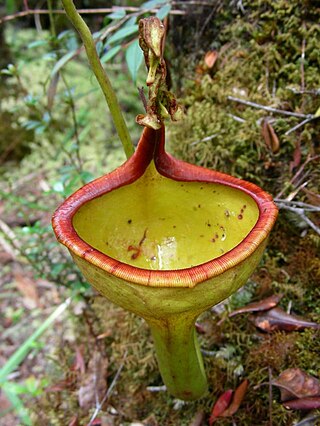
Nepenthes eymae is a tropical pitcher plant endemic to Sulawesi in Indonesia, where it grows at elevations of 1,000–2,000 m (3,300–6,600 ft) above sea level. It is very closely related to N. maxima, from which it differs in its wine glass-shaped upper pitchers.

Nepenthes lamii is a tropical pitcher plant endemic to New Guinea, where it grows at an altitude of up to 3520 m above sea level, higher than any other Nepenthes species. Although once confused with N. vieillardii and previously regarded as conspecific with the closely related N. monticola, it is now recognised as a distinct species.

Nepenthes jacquelineae is a tropical pitcher plant endemic to the Indonesian island of Sumatra. Due to its unique pitcher morphology, it is considered to be one of the most spectacular Nepenthes species native to the island.

Nepenthes tenuis is a tropical pitcher plant endemic to the Indonesian island of Sumatra. The species was first collected in 1957, from a remote mountain in the western part of the island. It remained undescribed until 1994, and was only rediscovered in the wild in 2002. Prior to this, N. tenuis was known solely from a single photograph and dried herbarium specimen.

Nepenthes rigidifolia is a critically endangered tropical pitcher plant endemic to Sumatra, where it grows at elevations of 1000–1600 m above sea level.

Nepenthes izumiae is a tropical pitcher plant endemic to Sumatra, where it grows in montane forest at 1700–1900 m above sea level. It appears to be most closely related to N. lingulata and N. singalana.

Nepenthes rhombicaulis is a tropical pitcher plant endemic to Sumatra. The specific epithet rhombicaulis is formed from the Latin words rhombicus, meaning "rhomboid", and caulis, "stem". It refers to the cross-sectional shape of the stem internodes.
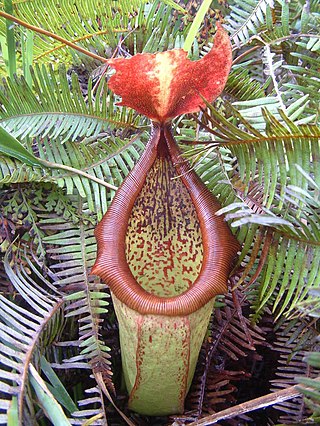
Nepenthes insignis is a tropical pitcher plant endemic to New Guinea and surrounding islands. The specific epithet insignis is Latin for "distinguished" or "remarkable".

Nepenthes lingulata is a tropical pitcher plant endemic to northern Sumatra. The species is characterised by the highly developed appendage present on the underside of the lid. The specific epithet lingulata is derived from the Latin word lingula, meaning "small tongue", and refers to this unique morphological feature.
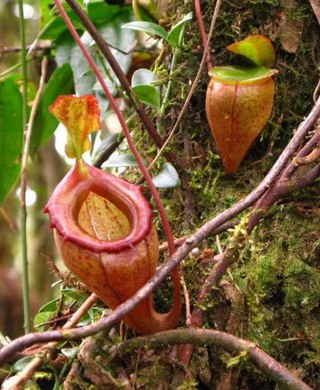
Nepenthes flava is a tropical pitcher plant endemic to northern Sumatra, where it grows in montane forest at 1800–2200 m above sea level.
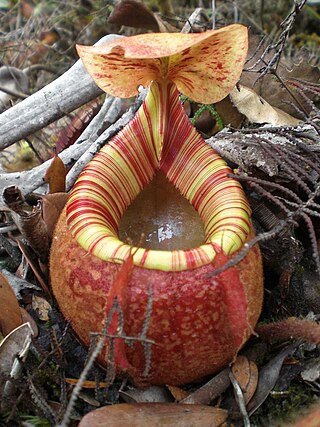
Nepenthes peltata is a tropical pitcher plant known only from the upper slopes of Mount Hamiguitan on the island of Mindanao in the Philippines. It is characterised by a peltate tendril attachment and conspicuous indumentum. The species typically produces ovoid pitchers with a prominent basal crest and large nectar glands on the lower surface of the lid.

Nepenthes naga is a tropical pitcher plant endemic to the Barisan Mountains of Sumatra. It is characterised by a forked sub-apical appendage on the underside of the lid and an undulate lid margin. The specific epithet naga is the Indonesian word for "dragon" and refers to the distinctive lid appendage of this species as well as the large size of its pitchers. The name also references local folklore, which tells of dragons occurring in this species's habitat in the past.
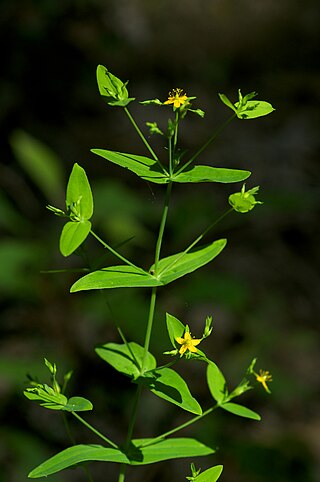
Hypericum mutilum is a species of St. John's wort known by the common name dwarf St. John's wort. It is native to parts of North America and is present in other parts as an introduced species. It is an annual or perennial herb taking a multibranched erect form up to about 60 centimeters tall. The oval green leaves are one or two centimeters long and are covered in tiny glands. The inflorescence is a compound cyme of tiny flowers. H. mutilum subsp. mutilum and subsp. boreale have a diploid number of 16, and H. mutilum subsp. boreale can have a diploid number of 18.
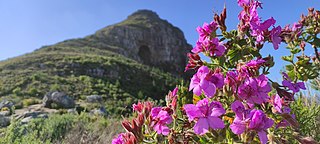
Pelargonium cucullatum is a hairy, upright, branching, perennial shrub, of 1–2 m (3.3–6.6 ft) high, that has been assigned to the cranesbill family. It sprouts new stems from the underground rootstock and becomes woody at its base. It has alternately set, sometimes slightly succulent leaves crowded near the top of the branches, with leaf stalks and flat to hood-shaped leaf blades, with a rounded broad triangular to kidney-shaped outline of about 4–5.5 cm long and 5–9 cm wide, often somewhat incised, the margin with irregular teeth. The white to purplish red, 5-merous, somewhat mirror symmetrical flowers grow in umbel-like clusters, and each contain mostly 7 fertile stamens and 3 infertile staminodes of different length. P. cucullatum has been cultivated as a garden ornamental and house plant since the 17th century. It has been used to breed many modern pelargonium hybrids, notably the Regal pelargoniums. It is called hooded-leaf pelargonium or herba althaea in English and wildemalva in Afrikaans.

Boerhavia erecta, commonly known as the erect spiderling or the erect boerhavia, is one of more than 100 species in the genus Boerhavia L. Boerhavia erecta is native to the United States, Mexico, Central America, Angola and western South America, but now is cosmopolitan in tropical and subtropical regions. In Africa its distribution extends from West Africa, eastwards to Somalia and down to South Africa. It has recently been found in parts of Madagascar and Réunion. In Asia, it occurs in India, Java, Malaysia, the Philippines, China and the Ryukyu Islands.

Nepenthes abgracilis is a tropical pitcher plant native to the Philippines. It is known only from northeastern Mindanao, including Mount Legaspi. Little is known about the altitudinal distribution of this species, but the holotype was collected at 670 m.

Polanisia erosa is a sticky, 10–60 cm (3.9–23.6 in) high annual herbaceous species of flowering plant in the Cleome family, Cleomaceae, known by the common name large clammyweed. It has narrow clover-like leaves, and cream-coloured, frilly flowers with a yellowish centre, looking a bit like a small butterfly or a set of elk antlers. It naturally occurs in dry and sandy habitats in Texas and adjacent parts of Arkansas, Louisiana and Oklahoma.

Passiflora bogotensis is a climbing plant native to Colombia, in the genus Passiflora. It can also be found in Venezuela.
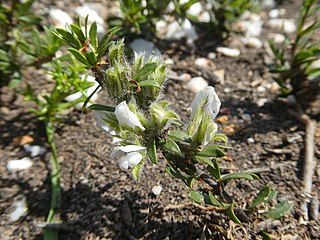
Otholobium curtisiae is a small spreading shrub assigned to the Pea family. All green parts are covered in hairs and urn-like glands. It has many woody stems, small and somewhat succulent, dark green alternately set clover-like leaves and heads consisting of 3-9 white, pea-like flowers on very short peduncles in the axils of the leaves. This species is an endemic of the Overberg area in the Western Cape province of South Africa. It mostly flowers in August and September.
Thymus capitellatus is a species of flowering plant in the mint family Lamiaceae, endemic to Portugal.





















